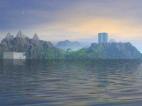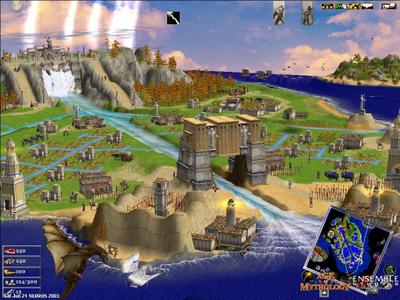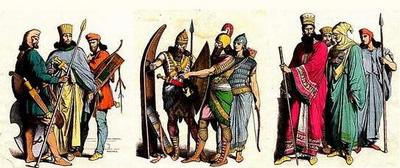 Two New Theories: Aryans were not Immigrantsand Achaemenians Reached Central America These two new theories on two exciting topics are independent from each other. But both, the result of a few decades of researches, are being discussed on papers, websites and ....
Two New Theories: Aryans were not Immigrantsand Achaemenians Reached Central America These two new theories on two exciting topics are independent from each other. But both, the result of a few decades of researches, are being discussed on papers, websites and ....
Here I am going to introduce both: Dr. Jahanshah Derakhshani and Dr. Jahangir Mazhare. -Siamak D. Ahi
Dr. Derakhshani’s research, The Aryans in the Near Eastern Sources from 4th to 2nd Millennium BC, found recognition in the community of experts, as you can read the comments on his work. http://www.int-pub-iran.com/ipis05_Briefe.htm He has been invited by scientific institutions to present his new theory.
Based on Dr. Drakhshani's theory, "Iran" newspaper is suggesting the review and rewriting of history of middle east: http://www.int-pub-iran.com/Farsi/IRAN830919.htm
I became familiar with his theory through Indian internet comunities. There is also a posting on wikipedia: http://en.wikipedia.org/wiki/Aratti_theory . His work is published by International Publication of Iranian Studies: http://www.int-pub-iran.com/index.html
In an interview with Shargh newspaper http://www.int-pub-iran.com/Farsi/Shargh%20Newspaper.htm Dr. Derakhshani talks about himself and his work:

Aryans Were Not Immigrants
An Interview With Dr. Derakhshani
Sharq, Daily Newspaper, No. 221, Jun. 22nd, 2004, :
Amir Hossein Rasael
The history is going ahead and being registered. The mankind cannot change the course of the history or adjust its transition speed. But certain theories may emerge about ancient clans. The history of Aryans is an example. Historians take as granted that Aryans lived two millennia Before Christ but Iranian professor Jahanshah Derakhshani has proof that the history of Aryans date back to three millennia BC. The veteran historian has carried out research for nearly 15 years to prove that Aryans were born in the Persian land and they were not migrants.
Dr Derakhshani Born in Tehran in 1944, He got his master degree in architecture and urban planning from Germany. He has been involved in historical research and linguistics in Germany for more than 20 years. He got his PhD in history from Yerevan University. His books and articles about ancient Iranian history enjoy international reputation. His latest works about Aryans were published in German some five years ago. Q: Iranians are not familiar with the topic of your research. Can you explain about it? A: The book reviews the history of ancient tribes who lived in Persia. Historians are not familiar with that period because non-Persian clans lived at those periods. My book studies ethnic Aryans who lived up to the second millennia BC. Q: How come you found a vacuum in Iran's chronology and where does your research stem from?
A: There is no background about this research. Historians are of the view that Iranians did not live here at that time and they attribute the lives to migrants. That is why the tribes who lived at that time are obscure. That is the case while traces of Persian civilization date back to the sixth millennia BC. No serious work has been done about the history of ancient Persians. The history of Iran starts from the time Assyrian historians wrote about Mad, Pars and Achaemenians. I have carried out the first research about those who inhabited in Iran Plateau. Q: Your studies dismiss the common view that Aryans had migrated to the Iranian Tableland. How do you justify your standpoints? A: Aryans are believed to have lived in Iran Plateau in the second millennium BC. But the reasons for such view lack any scientific standing. There is enough evidence to prove that even Mad and Pars tribes lived in Iran in the third millenium BC. The idea of migration originates from European Fascism which emerged in the late 19th century. The Europeans believe that a blond race migrated to Iran and India but they do not offer any evidence for this migration. Their latest surveys have even attributed the original land of Aryans to Central Asia, Russia, the Smaller Asia and even the Mesopotamia. But I have found that the Aryans emerged from Iran Plateau. Q: Your study says Aryans did not migrate from the now Europe to Iran. Did they move from somewhere else or they were born in Persian land? A: A variety of evidences should be taken into account. A sole linguistic or archeological evidence cannot respond to our question. My study is based on paleontology, meteorology, mineralogy and linguistics. I have concluded that Aryans lived in Iran some 10,000 years BC. It was very cold at that time and the Aryans had to move to higher regions and they finally reached Iran Plateau. Finally, Aryans moved up to north of Europe. This idea has scientific and historical bases. The ancient language of Aryans is originated in north of Europe. Q: Can you yell us of the Aryan Diaspora? A: The biggest expansion of Aryans takes place in the middle of fifth millennium BC. Aryan tribes move to Europe, Palestine and Syria at the same time. They even leave trails of civilization in Egypt. The second wave of immigration transpires in the early second millennium BC. Aryans go to Greece and India. Q: What is the reason behind the immigration? Are geographical reasons like warming or other issues related to agriculture and cattle breeding behind the migrations? A: We have access to scientific surveys about meteorological conditions. The weather had started to warm and Aryans had to seek water resources. They mainly moved towards Tigris, Euphrates, Nile and Sindh rivers. Therefore, hot weather was the main reason behind migration of Aryans. Q: Your research is pervasive. How come you decided to carry out such extensive research? A: In recent decades, linguists and archeologists have been divided in their interpretation of ancient tribes. I have resorted to a combination of different branches of science notably paleontology and meteorology to reach correct results. Pictures depicting Aryans are found even in host nations like Egypt or Mesopotamia. Such phenomena bear proof to the fact that Aryans were determined to broaden their tribal and cultural relations with the world. if we review Iranian legends we will find relations between Aryans and Europeans. Q: What other tribes lived in Iran before Aryans? A: My research proves that fact that before Aryans, other tribes lived in Iran Plateau. Aryans who moved to Greece borrowed 40 percent of non-Aryan terms. 25 percent of Sanskrit terms are non-Aryans. But that is not the case for ancient Persian and it proves that non-Aryans never lived in Iran Plateau. Khuzestan was home to Elamites who do not speak Aryan. Q: Where did Aryans live before coming to Iran? A: First of all I ask you if the Aryans should have come from another region to Persia. Not necessarily! The fact is that it was very cold and Aryans could not live for a period of time. But the Persian Gulf was good for living. Iranian and European legends also prove that Aryans lived in southern regions. After thousands of years, Persian Gulf is replete with water and Aryans had to move. Afterwards, they had to move northward to build houses. Q: Is there any other proof than linguistic signs to demonstrate inhabitation?A: The Persian Gulf bed has not yet undergone archeological discoveries. But we know that a big valley was created at the confluence of Karoun, Tigris and Euphrates. A wide river was flowing to Oman Sea through the Strait of Hormuz. Q: Now we go to the time that Aryans resided in Iran Plateau and boost cultural ties with the neighbors. How could ancient Aryans make relations?
A: Historical surveys have focused on the relations between native Iranians and residents of Syria, Palestine and Egypt. They have rarely reviewed relations between Iran and China or Korea. Q: What about religions? Did Aryans believe in multiple gods before Zoroaster? A: Aryans had diverse gods. Unlike other civilizations that worshipped idols, Aryans never bowed to idols and no traces have been found. Ahuramazda was the only divine god for Aryans. Q: Were Aryans dominated by kings? A: Iran Plateau was independent and there was no central government. But Achamenians established a central government. Q: You have stemmed Aryan history in other languages and civilizations. Is there any manuscript? A: The oldest trace of Aryan language in Iran is the language of Avesta which dates back to the second millennium BC. The more common manuscript was found after revelation of Islam. Q: Is there any trace of confrontation between Iranian and non-Iranian culture of that time? A: Yes. Aryan geographical terms were used in Near Eastern countries like Egypt, Syria, Palestine and Mesopotamia. Many of these countries switched to Arabic when Islam was revealed. But the current Arab language contains ancient Persian words. The names of Syria, Egypt and Palestine have no Arabic root. Q: Does the same go for European mountains and rivers? A: Yes, Aryans transferred their words to Europe. The names of European rivers originate from Aryan terms. Q: Which tribe have you mainly focused on? A: All tribes who lived in Iran. Diverse tribes were scattered in Iranian Plateau. Q: Were they all Aryans? A: Yes, they lived in different spots but they left traces. My book contains 360 pictures of these tribes. Q: You have compared the skulls of Aryan and Egyptian people. Are they from different races?A: We better use "culture" instead of "race". If we turn back to many years ago we would realize that other races had joined Aryans. Today, we recognize as Aryans anyone who believes in Aryan culture. Many blacks who live in the United States or Europe are of Indian origin but they speak English or French and so they have American or European culture. Q: When did Aryans start to scatter? A: We can respond to this question through the language they spoke. From a linguistic standpoint, Aryan language has influenced the entire world and Korean language contains around 200 Aryan words. You must know that Koreans are totally different from Japanese and Chinese. We may find tall Koreans with blue eyes but we rarely find such cases in Japan or China. Therefore, Aryans have even affected the Korean culture. Ancient Persian terms are also used in West and North Europe -- Finland and Hungary. If we follow up the roots we will find that Aryans had not started to scatter even in the fifth millenium BC. Q: What is your assessment of Aryan economy? A: Aryans did not enjoy from the same economy. They were involved in metallurgy, pottery, making chariots, horse breeding, agriculture, exports and other commercial affairs. Iranians produced copper ingots at that time. Archeological discoveries prove that Persians took cooper ingots to Egyptian Pharaohs. They had also unearthed tin, bronze, iron and precious stones like emerald and precious metals like gold and silver. Q: What about astronomical and medical progress? A: Iranians exported herbs and it proves that they were familiar with medicine. Zoroastrian books prove proof to astronomy. Persian culture had influenced the Greek culture before the Achaemenians. Q: Can you tell us about the idea of democracy in ancient Persia? A: Cambysis was killed or committed suicide in his military campaign against Egypt. Darius the Great gathered the Iranian governors to debate formation of a new government. They raised democracy which came against Cambysis autocracy. Q: Do other nations hold any memory of Aryans? A: Legends have all referred to Persian culture. Thoara, Avesta and other fables say three rivers had joined to form a bigger river -- that is now the Persian Gulf. They have exactly described the surrounding regions of the Persian Gulf. Q: Did non-Aryans live in Iran? A: The only tribe was Elamites who lived in Khuzestan region. Q: How long did it take you to conduct your research? A: Fourteen years. I spent four to five years on gathering reliable sources. All my references were in German and I used no translation. Q: So you found your resources in libraries? A: I have relies on foreign books and microfilms. Q: Your book was published in German five years ago. How has it been reflected in the scientific and academic circles? A: My book was printed in 1998. I also wrote other articles for scientific magazines. As you know new ideas face scientific deductions. My book managed to win the world endorsement because of reliable sources. A number of conferences were held and I was invited to deliver my speech. Q: What are you planning to do in future? A: The two volumes of the book which is now under translation proves the presence of Iranian tribes in Iranian Plateau since the outset of civilization. I introduce the tribes in summary. In my next works, I am determined to go through details and touch on other aspects of lives.
A talk with Dr. Jahangir Mazhari is all I found on his work. He is educated in Iran and France. Sociology and literature is what he studied and worked with well known French masters.Achaemenians Reached Central AmericaBased on Dr. Mazhari's theory, after defeat of Dariush the III in 330BC, some Iranian emigrated from Iran on the ships and some ended up in Centeal America and.....Dr. Mazhari went to Iran after 25 years for publishing this work. He doesn't expect much attention to this work in the west, because of questioning the discovery of America. He is also sensitive about Persian Gulf and ....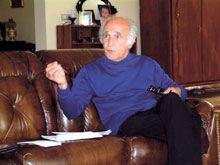
گفت وگو با دكتر جهانگير مظهرى
هخامنشيان كاشف قاره آمريكا
دكتر جهانگير مظهرى پس از سال ها تحقيق و مطالعه مدعى است كه به كشفى نائل شده كه هنوز از تمامى آن پرده بر نداشته است.او كه پس از ۲۵ سال دورى از ايران، براى چند روزى بازگشته مى گويد: «تا كتابم كه در آن شرح كشف خود را شواهد كافى آورده ام، چاپ نشود، نمى توانم چيزى اعلام كنم.»
او مدعى است كه در جست وجو هايش نشانه ها و شواهدى يافته كه ثابت مى كند درست بعد از شكست داريوش سوم از اسكندر و فروپاشى امپراتورى هخامنشى در سال ۳۳۰ پيش از ميلاد، بسيارى از ايرانيان پراكنده شدند و آنها كه به آمريكاى مركزى راه يافتند امپراتورى هاى ديگرى بنيان نهادند و در واقع، آنان قبل از كريستف كلمب اين قاره را كشف كرده اند!
او واكنش دنياى غرب را نسبت به اين ادعا مى داند. هرچند كه مى گويد برايش اصلاً اهميتى ندارد. سپس با عصبانيت به اهداى يك اطلس جغرافيايى در همين اواخر به ملكه انگلستان اشاره مى كند كه در آن كلمه فارس را از خليج فارس پاك كرده و فقط به كلمه خليج اكتفا كرده اند و مى گويد: «انتظار تشويق و تكريم ندارم چون چيزى در كشف من به نفع آنها نيست شايد دوست داشته باشند دزدان دريايى تاجرنماى اسپانيولى- ايتاليايى كاشف قاره شان باشند تا دريانوردان غيور ايرانى.»
دامنه صحبت هاى او بسيار گسترده است. از تاريخ آغاز مى كند، به جغرافيا كه مى رسد ما را در احاطه نقشه هايش كه به ديوار نصب كرده قرار مى دهد و در زبان شناسى و مردم شناسى حل مى شود. جمع وجور كردن گفته هاى او كارى دشوار است.
جهانگير مظهرى متولد سال ۱۳۱۱ در تهران، تحصيلات دانشگاهى را در ايران و پاريس در رشته هاى جامعه
شناسى و ادبيات چند فرهنگى در محضر اساتيدى چون ژرژگوريچ، ريمون آرون، هانرى ماسه و... به پايان رساند و از آن پس ضمن تدريس و تحقيق در مورد ايران به سخنرانى هاى بسيار در كشور هاى مختلف پرداخته است.
«نقش انسان در آفرينش اهورايى»، «گناه آفتاب»، «جلوگيرى هاى نامرئى»، «بى دود و بدون خاكستر» و مقالات و ترجمه هايى به زبان هاى فرانسه، اسپانيولى، انگليسى و فارسى و سرانجام كتاب «آمريكايى پارسيان هخامنشى» از آثار اوست. متن زير مصاحبه اى است كه با ايشان صورت گرفته است.
•••• و اما درباره كشف شنيدنى شما آقاى دكتر...
 New Exhibition In British Museum
New Exhibition In British Museum

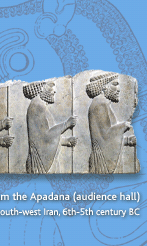 The title of this exhibition is a bit misleading. Forgotten Empire, the British Museum calls its spectacular resurrection of ancient Persia. Yet the Persians are as notorious in their way as Darth Vader, the Sheriff of Nottingham, General Custer, or any other embodiment of evil empire you care to mention. They are history's original villains.
The title of this exhibition is a bit misleading. Forgotten Empire, the British Museum calls its spectacular resurrection of ancient Persia. Yet the Persians are as notorious in their way as Darth Vader, the Sheriff of Nottingham, General Custer, or any other embodiment of evil empire you care to mention. They are history's original villains. 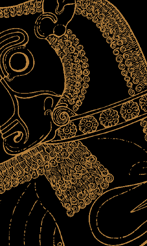 Persia was not an Evil Empire
Persia was not an Evil Empire  Evil Empire or Evil Intentions
Evil Empire or Evil Intentions